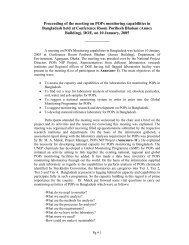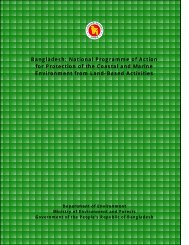Draft CMP HH - the Department of Environment
Draft CMP HH - the Department of Environment
Draft CMP HH - the Department of Environment
Create successful ePaper yourself
Turn your PDF publications into a flip-book with our unique Google optimized e-Paper software.
Coastal and Wetland Biodiversity Management Project BGD/99/G31<br />
Hakaluki Haor <strong>Draft</strong> Conservation Management Plan<br />
7.2.11 Horticulture<br />
Horticultural activities in <strong>the</strong> ECA are typified by small homestead gardens producing a variety <strong>of</strong><br />
fruit and vegetables. Homesteads are usually located at <strong>the</strong> periphery and adjacent to elevated<br />
fallow lands <strong>of</strong> <strong>the</strong> Haor. Some <strong>of</strong> <strong>the</strong> more common vegetables include rye, sweet gourd, long<br />
bean, tomato, eggplant, chilli, radish, bottle gourd, okra, and cabbage, while <strong>the</strong> fruit varieties<br />
grown mostly consist <strong>of</strong> lychee, jackfruit, mango, coconut, guava, banana, lime, carambola, and<br />
hogplum. Generally fruit and vegetable are grown for personal consumption, however, some are<br />
sold in nearby markets to help supplement household incomes. One <strong>of</strong> <strong>the</strong> key advantages <strong>of</strong><br />
horticultural cash crops is that <strong>the</strong>y help to reduce <strong>the</strong> pressure on wetlands resources which are<br />
<strong>of</strong>ten harvested as a way <strong>of</strong> generating additional income.<br />
When <strong>the</strong> Haor floods many <strong>of</strong> <strong>the</strong>se homestead gardens especially <strong>the</strong> lower lying ones become<br />
inundated and as a result unusable. This natural phenomenon is one <strong>of</strong> <strong>the</strong> major limiting factors for<br />
<strong>the</strong> introduction horticultural activities as a dependable way <strong>of</strong> generating an additional income<br />
stream for poor families.<br />
Although <strong>the</strong>re are potential benefits to be derived from <strong>the</strong> development <strong>of</strong> more productive and<br />
economically viable homestead gardens, <strong>the</strong>re are also potential disadvantages. Of most concern is<br />
<strong>the</strong> indiscriminate use <strong>of</strong> agrochemicals such as pesticides, herbicides, fungicides, and fertilisers<br />
which affect soil fertility, contaminate water, and pose a threat to public heath.<br />
Management Actions<br />
• Involving local communities and relevant government agencies collect ecological baseline<br />
information concerning <strong>the</strong> full range <strong>of</strong> horticultural crops in and around Hakaluki Haor<br />
including:<br />
� The number and type <strong>of</strong> different<br />
varieties currently being cultivated<br />
� Preferred habitat and soil type<br />
associated with each variety<br />
� Seasonal and spatial distribution <strong>of</strong><br />
different crops<br />
� Existing crop rotation patterns<br />
� Irrigation requirements<br />
� The range <strong>of</strong> pests and diseases<br />
affecting crops<br />
� Current mechanisms for controlling<br />
pests and disease<br />
� Current type and use levels <strong>of</strong><br />
pesticides, herbicides, fungicides, and<br />
fertilisers<br />
� Potential for using organic and<br />
environmentally safe alternatives to<br />
pesticides, herbicides, fungicides, and<br />
fertilisers<br />
• Involving local communities and relevant government agencies collect socio-economic baseline<br />
information relating to each horticultural crop grown in and around Hakaluki Haor including:<br />
� The variety <strong>of</strong> different uses<br />
� Cultural practices associated with<br />
associated with each crop<br />
each horticultural crops<br />
� Whe<strong>the</strong>r <strong>the</strong> crop is used for self-<br />
� Seed sources, storage, and treatment<br />
consumption or sold in <strong>the</strong> market<br />
� Seed cost and availability<br />
� The economic viability including<br />
potential return associated with each<br />
crop and how this relates to <strong>the</strong> size<br />
<strong>of</strong> each garden<br />
�<br />
�<br />
Market, processing and transportation<br />
<strong>of</strong> horticultural crops<br />
Health benefits associated with each<br />
crop<br />
• Involving local communities and relevant government agencies collect information concerning<br />
<strong>the</strong> potential for introducing new horticultural crops especially those that have promise for<br />
Prepared by UNOPS Consultant Mr. Sulma Warne August/ September 2005 for Project BGD/99/G31 30





